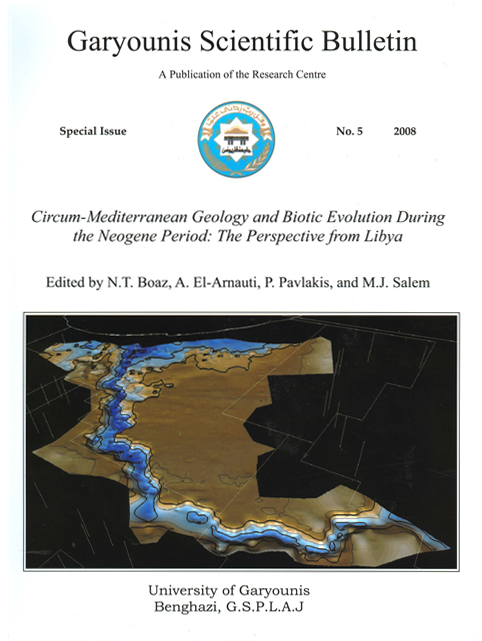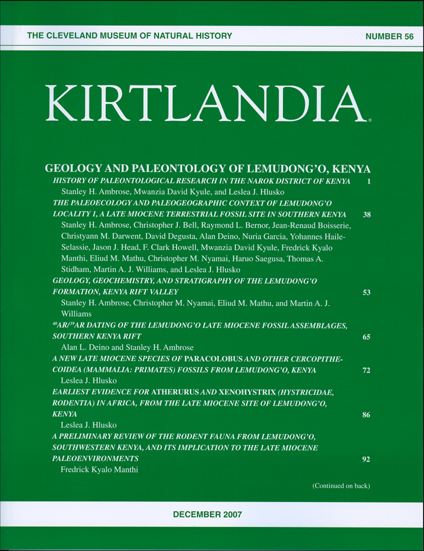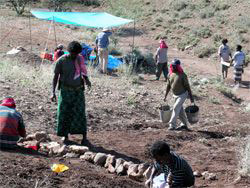HOME • EDUCATION • RHOI PUBLICATIONS • RHOI BIBLIOGRAPHY • RHOI STRUCTURE • INFORMATICS • MAP ARCHIVE: CORE PROJECTS
|
|
2008 BENGHAZI, LIBYA (RHOI-supported) A special issue on the geology and paleontology of the Late MioceneEarly Pliocene site of As Sahabi, Libya has recently been published in the Garyounis Scientific Bulletin (Boaz, N. T., A. El-Arnauti, P. Pavlakis, and M. J. Salem. (2008) Circum-Mediterranean Geology and Biotic Evolution during the Neogene Period: The Perspective from Libya. Garyounis Scientific Bulletin, Special Issue No. 5. Benghazi, Libya: University of Garyounis.) An analysis of material recovered from fieldwork dating as far back as the 1930s is presented including fossils recovered during the RHOI-supported 2007 field season. As of 2008, a total of 30 large mammal taxa have been recovered from the Sahabi Formation, dated biochronologically and geochronologically to 7.2-7.5 Ma. In depth discussions of the development of the Sirt Basin and the role of North Africa as a biogeographic crossroads are presented. The final chapter discusses the paleoecology of Sahabi and compares it with the site of Toros Menalla, Chad (where Sahelanthropus tchadensis was discovered in 2001), to evaluate the potential of finding hominid remains within the Sahabi sediments.
(Image: University of Garyounis)
LEMUDONG'O, KENYA (RHOI-supported) A special issue on paleontological and geological work at the late Miocene site of Lemudong’o, Kenya has been published in the journal Kirtlandia (Number 56, December 2007). The seventeen articles within this issue detail the history of research at Lemudong’o and describe some of the 1268 vertebrate specimens in 48 taxa found over the course of fieldwork spanning 1994-2005. Among the finds is a new species of Paracolobus (P. enkorikae) described in detail by L. Hlusko (L. Hlusko (2007) A new late Miocene species of Paracolobus and other Cercopithecoidea (Mammalia: Primates) fossils from Lemudong’o, Kenya. Kirtlandia 56: 72-85). Though research at Lemudong’o yielded no hominid fossils, an understanding of the paleoenvironment of the Narok district, Kenya at 6.1 Ma is invaluable for understanding habitat preferences of the earliest members of the human lineage. Continue to monitor this newsfeed for further updates of research on the evolution and paleobiology of early hominids.
(Image: Cleveland Museum of Natural History)
2005 GONA, ETHIOPIA (RHOI-supported) P.I. Sileshi Semaw and colleagues announced in the January 20 edition of Nature new material of Ardipithecus ramidus from As Duma, Gona Western Margin, Afar, Ethiopia. As Duma, dated to between 4.51 and 4.32 million years, is now the second locality to yield Ar. ramidus, after Aramis, dated to 4.4 million years. RHOI-sponsored fieldwork is continuing in the Gona Western Margin. Gona, Ethiopia (Image: Sileshi Semaw)
2004 M.P.F.T., CHAD (RHOI-supported) Three RHOI supported field missions took place in the Lake Chad basin in 2003 and 2004. These efforts focused on the upper Miocene site of Toros-Menalla (TM), and saw the collection of sediment samples and the systematic collection of micro and macrovetebrates at hominid localities. RHOI supported laboratory work reconstruction the cranium of Sahelanthropus using CT imagery and paleozoological analyses of several taxa from the Toros-Menalla assemblage. Look for publications in the near future. link M.A.R.P. WESTERN MARGIN, ETHIOPIA (RHOI-supported) Exploration of the northwest quadrant of the Middle Awash study area during the 2003 field season was focused on the area near the Jara/Borkana river junction, and on the plateau above Dallifage where new localities were found and named, and overlying basalt flows were sampled for Ar/Ar dating. Limited vertebrate remains were found on these outcrops. Exploration was extended into the western tributaries of the Wallia drainage where major basalt-capped blocks tilting synthetically into the rift at attitudes of >35 degrees were found. The area was found to be bushy, steep, and therefore only poorly accessible compared to more southerly outcrops at Alayla and Saitune Dora. Foot and vehicle survey was suspended after this result. Further survey is indicated for the 2004 field season in the headwaters of the Jara River. LEMUDONG'O, KENYA (RHOI-supported) RHOI supported field research was conducted in July, 2004. Dr. L. Hlusko, Dr. S. Ambrose, and Dr. C. Nyamai led a group that worked at Lemudong'o, Enamon Kewon, and at Kasiole near the Ntuka River. At Lemudong'o they conducted extensive sieving of secondary deposits to recover previously eroded specimens. They collected data to devise a site map of the collection areas and to constrain provenience. Extensive sampling from the geological strata was conducted in order to build a comprehensive stratigraphic column of Lemudong'o and the surrounding fossiliferous sites. RHOI supported laboratory research was performed primarily by two researchers, F. Kyalo and L. Hlusko. G.P.R.P., ETHIOPIA (RHOI-supported) The Gona Paleoanthropological Research Project undertook research in upper Miocene and lower Pliocene deposits in the Awash Basin of Ethiopia, collecting a large number of vertebrate specimens. Stratigraphic work and geochronological sample collection progressed, and arrangements have been made for Ar/Ar dating. RHOI funding contributed to organization and storage of the large number of fossils turned over to the National Museum of Ethiopia by the Gona Project. link |



